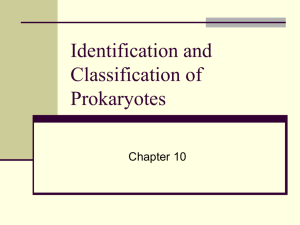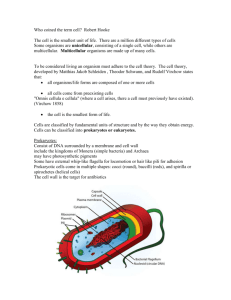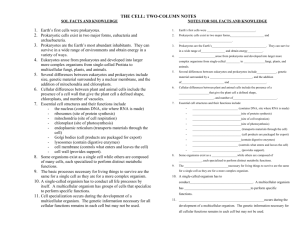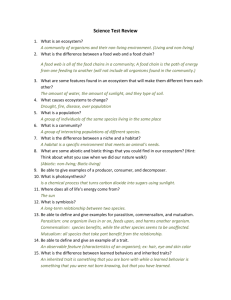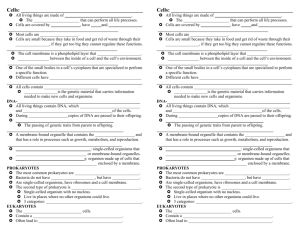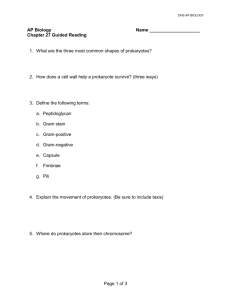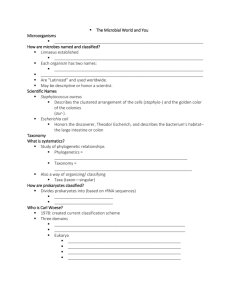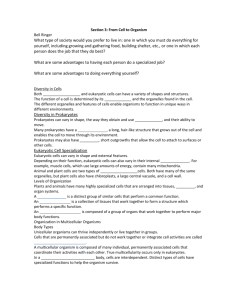Identification and Classification of Prokaryote
advertisement
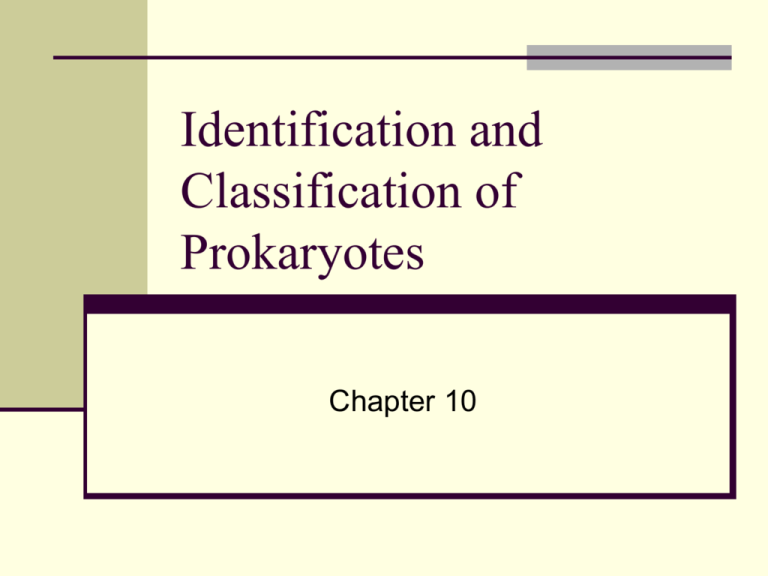
Identification and Classification of Prokaryotes Chapter 10 Identification and Classification Living organisms are divided into groups to better understand relationships among species Taxonomy is the science that studies organisms to order and arrange them Taxonomy can be viewed in three areas Identification Process of characterizing in order to group them Classification Arranging organisms into similar or related groups Nomenclature System of assigning names Principles of Taxonomy Strategies Used to Identify Prokaryotes Wide assortment of technologies used to identify organisms including Microscopic examination Culture characteristics Biochemical test Nucleic acid analysis Principles of Taxonomy Strategies Used to Classify Prokaryotes Understanding organisms phylogeny assists in classification Allows for organized classification of newly recognized organisms Development of molecular techniques for classification and identification make genetic relatedness possible Principles of Taxonomy Taxonomic hierarchies Classification categories arranged in hierarchical order Species – group of related isolates or strains Most basic unit Genus – group of related species Family – collection of similar genera Order – collection of similar families Class – collection of similar orders Phylum – collection of similar classes Kingdom – collection of similar phyla Domain – collection similar to kingdoms New taxonomic category Principles of Taxonomy Classification system No such thing as “official” classification system Scheme favored by most microbiologists is three domain system Before three domain system five kingdom system was used Principles of Taxonomy Nomenclature Names given according to International Code for the Nomenclature of Bacteria Using Phenotype to Identify Prokaryotes Phenotype can be used in the process identification of bacteria Methods used include Microscopic morphology Metabolic capabilities Serology Using Phenotype to Identify Prokaryotes Microscopic morphology Important initial step in identification Can be used to determine size, shape and staining characteristics Size and shape can readily be determined microscopically Gram stain differentiate Gram + from Gram – Narrows possible identities of organism Special stains Identifies unique characteristics of organisms Acid fast stain Using Phenotype to Identify Prokaryotes Metabolic capabilities Identification relies heavily on analysis of metabolic capabilities Culture characteristics Colony morphology can give clues to identity Red pigment of Serratia marcescens Biochemical tests More conclusive identification Most test rely on pH indicators Commercial biochemical tests allow for series of test with single inoculation Using Phenotype to Identify Prokaryotes Serology Technique relying on specific interaction between antibodies and antigens Serological tests are available for rapid detection of numerous organisms Streptococcus pyogenes the causative agent of strep throat Using Genotype to Identify Prokaryotes Nucleic acid probes can locate unique nucleotide sequence of a particular species Numerous technologies discussed previously are being used to identify organisms based on genotype Advantage Identification of organism that can’t be grown in culture Using Genotype to Identify Prokaryotes Using PCR Used to amplify sequences that allow for detection of specific sequences for identification Sequencing ribosomal RNA genes There is little genetic variation in rRNA Newer technologies are available to sequence rDNA The DNA that encodes rRNA Characterizing Stain Differences Biochemical typing Biochemical tests can be used to identify species They can also be used to identify strains by tracing specific biochemical characteristics called biovar or biotype Serological typing Identification made based on differences in serological molecules Serological characteristics are termed serovar or serotype Characterizing Stain Differences Phage typing Certain strains of given species susceptible to various bacteriophages a.k.a phage Virus that infect bacteria Phage typing identifies organism by phage that infect them Phage type has been largely replaced by molecular methods Characterizing Stain Differences Antibiograms Identifies organism based on antibiotic susceptibility Disc impregnated with antimicrobial placed on inoculated plate Clear are indicates microbial susceptibility Different strain will have different susceptibility patterns Classifying Prokaryotes Classification historically based on phenotype Size, shape, staining characteristics and metabolic capabilities New molecular techniques make identification more accurate Allows for accurate construction of phylogenetic tree Trees show divergence and relationships between organism Molecular techniques highlighted transfer mechanism of prokaryotic cells Horizontal or lateral transfer of DNA Classifying Prokaryotes Sequencing methods include 16s rDNA sequence analysis Comparison of 16s rRNA and rDNA sequences revolutionized classification Lack of mutation allows identification of distant relatedness DNA hybridization better tool for assessing related ness on species level Classifying Prokaryotes DNA hybridization Relatedness of organism can be determined by similarity of nucleotide sequences Sequence homology is measured by DNA hybridization Extent of hybridization reflects degree of similarity If two strain show high percentage of DNA hybridization they are considered related 70% similarity is considered same species Classifying Prokaryotes DNA base ratio Comparison of genomes to determine DNA base ratio Looking at relative proportion of A:T and G:C bonding in DNA Base ratio is expressed in G:C content If GC ratio deviate more than a little organism are not related Similarity of base composition does not mean relatedness
